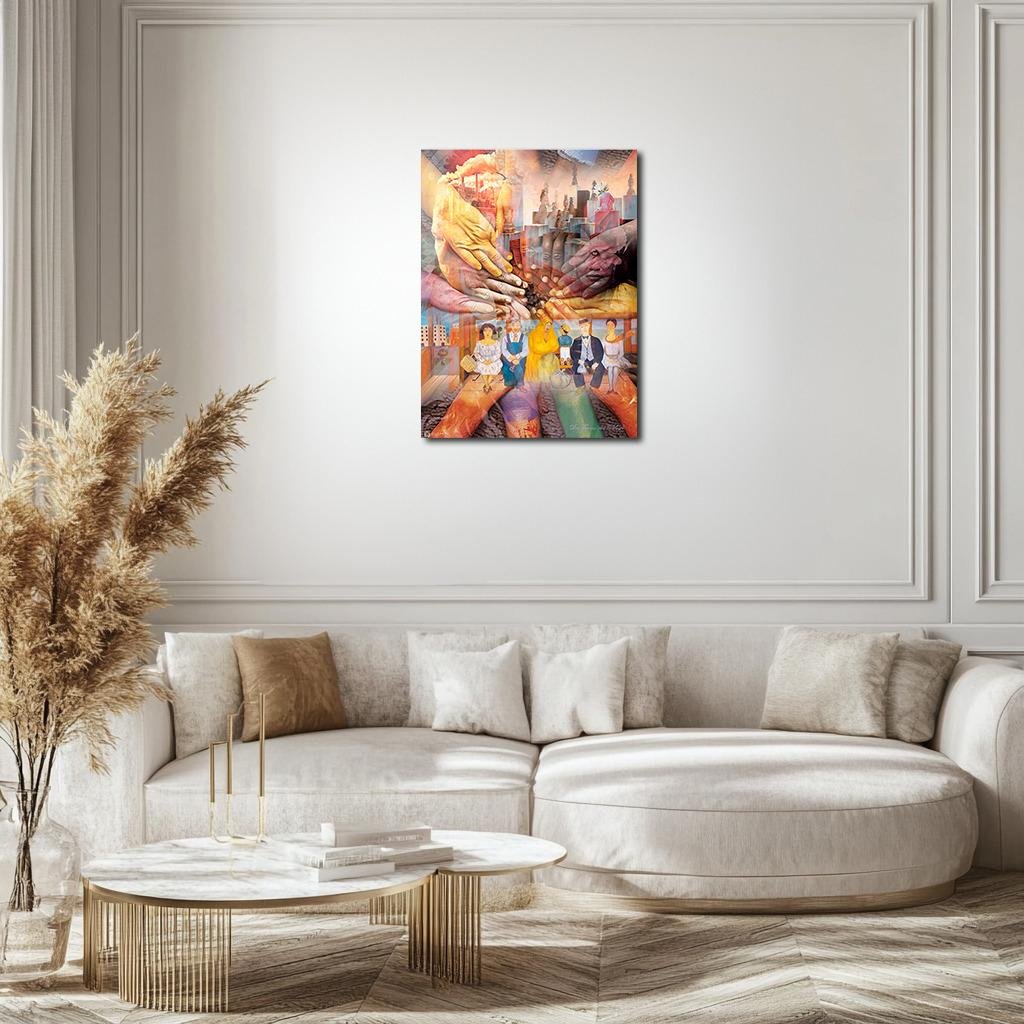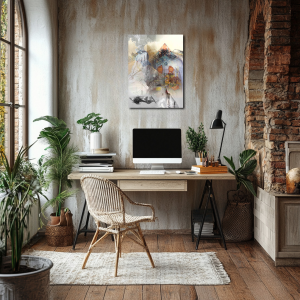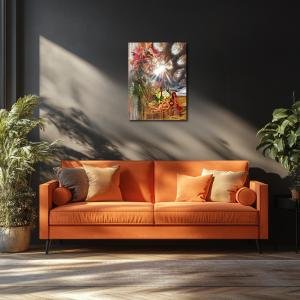The Weight of Waiting: Frida’s Communal Flesh
The Weight of Waiting reimagines Frida Kahlo’s The Bus as a global meditation on shared stillness and the unseen bond between strangers. Through earth-toned hands, weathered palms, smokestack grays, and vibrant ochres, Kahlo’s quiet bench scene becomes a collective portrait of labor, class, and silent solidarity. Encircled by hands and hemmed by industry, each figure breathes in the same uncertain pause—reminding us that even in waiting, there is memory, resilience, and meaning.
Please see Below for Details…
Hotline Order:
Mon - Fri: 07AM - 06PM
404-872-4663
This conceptual reimagining of Frida Kahlo’s The Bus expands her quiet scene of public stillness into a layered meditation on labor, survival, and the textures of collective endurance. Titled The Weight of Waiting , the piece turns a moment on a bench into a convergence of class, skin, smoke, and silence—offering not merely a portrait of Mexican society, but a global image of unseen humanity, bound together not by similarity, but by circumstance.
At the heart of the composition rests the original configuration of seated figures, their legs dangling above the curb, their bodies paused in waiting. A construction worker in a yellow cloak, a bourgeois woman in heels, a blue-eyed capitalist, an indigenous mother nursing her baby, and a soft-faced Frida herself. But here, these characters are not frozen in painted realism—they are absorbed into a tactile collage of clasped hands, industrial decay, and scarred palms pressed together in a universal plea.
Above and around these figures, a great ring of interlaced hands dominates the frame. These hands are the hands of workers, of migrants, of grandmothers, of children, of strangers, reaching not for embrace but for contact. Their skin tones range from honeyed amber to weathered mahogany, from olive dusk to ink-black—and none is untouched. Wrinkled, cracked, scraped, or bruised, each hand is a map of labor. They overlap gently but firmly, forming a circle around a roughened stone texture that radiates from the center of the image like a wound or a forgotten altar. The gesture is neither prayer nor protest, but something in between—a gesture of holding.
Embedded within this tactile gesture are ghosted silhouettes of urban architecture—smokestacks and gray tenement towers rising behind fingers, street monuments carved in shadow, anonymous statues draped in digital pinks and metallic rust. These structures are not framing the people; they are compressing them. The modern city looms like a structure too tight to house all its lives, and yet these lives sit quietly, their stories written into their bodies.
The color palette of The Weight of Waiting carries the emotional load of this collective stillness. The hands are rendered in tones that pulse with warmth and bruising: sienna, rosewood, dull lavender, ochre, and sun-drenched clay. Some are streaked with oil and soot, others touched with gold light. The variety is not decorative—it is necessary, insisting on multiplicity not as ideal, but as reality.
The background bleeds into grays, oranges, and fading smoke-blues—urban tones of both sunrise and smog. The smokestacks in the upper left pour crimson-tinted exhaust into a cloudless sky, their colorless repetition suggesting the cyclical exhaustion of factory life. Above the seated characters, pink and lavender hues emerge faintly, almost tenderly, around the stone and brick monuments. These soft tones evoke the unseen softness of the people themselves—reminding us that even in stillness, there is breath, warmth, and quiet complexity.
The figures from The Bus retain their distinct colors, but they’ve been gently intensified to reflect symbolic presence. The bourgeois woman’s white dress now glows faintly with the sterility of social distance, while the indigenous mother’s orange-yellow garment is richened into golden maize—offering ancestral gravity and the hue of corn, of life-giving earth. The capitalist man wears navy so dark it nearly blacks out, absorbing color rather than offering it. Frida’s soft blue is haloed in lilac and rose, echoing empathy, but not centrality. She is part of the row, not above it.
When I created The Weight of Waiting , I wanted to respond to the quiet profundity of Kahlo’s original composition. The Bus doesn’t shout. It observes. It captures a pause, a moment before impact, a breath shared by those who may never speak to each other again. In her real life, Kahlo’s accident on a bus forever changed her body. That moment of sitting beside strangers became the rupture that defined her life’s art. But in that scene of waiting, there is a deeper truth: all of us are seated on a vehicle whose path we cannot fully predict, side by side with those whose lives we barely understand.
The composition spirals inward from the outer hands toward the seated characters, then downward into the stones, inviting the viewer to feel the gravity that rests beneath the moment. The hands press gently, then heavily, then vanish into form. The people remain still—but the painting moves.
In this vision, Frida Kahlo is not only a painter of self—she is the chronicler of shared quiet, the recorder of seated strangers. Through her, we learn that the bus is not a symbol of destiny alone—it is the frame in which we are called to witness one another.
Add your review
Your email address will not be published. Required fields are marked *
Please login to write review!
Looks like there are no reviews yet.








